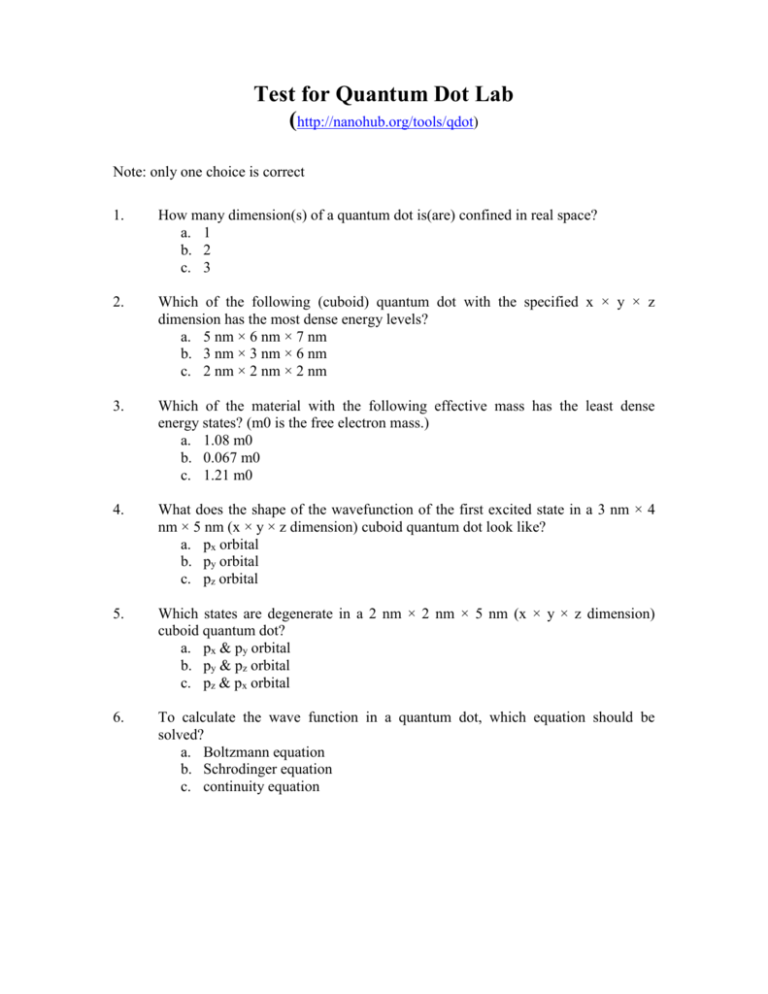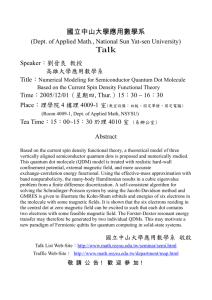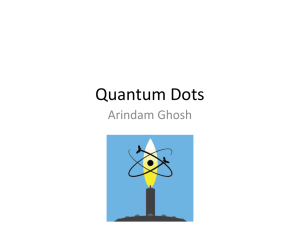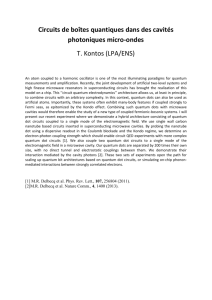quantum ev
advertisement

Test for Quantum Dot Lab (http://nanohub.org/tools/qdot) Note: only one choice is correct 1. How many dimension(s) of a quantum dot is(are) confined in real space? a. 1 b. 2 c. 3 2. Which of the following (cuboid) quantum dot with the specified x × y × z dimension has the most dense energy levels? a. 5 nm × 6 nm × 7 nm b. 3 nm × 3 nm × 6 nm c. 2 nm × 2 nm × 2 nm 3. Which of the material with the following effective mass has the least dense energy states? (m0 is the free electron mass.) a. 1.08 m0 b. 0.067 m0 c. 1.21 m0 4. What does the shape of the wavefunction of the first excited state in a 3 nm × 4 nm × 5 nm (x × y × z dimension) cuboid quantum dot look like? a. px orbital b. py orbital c. pz orbital 5. Which states are degenerate in a 2 nm × 2 nm × 5 nm (x × y × z dimension) cuboid quantum dot? a. px & py orbital b. py & pz orbital c. pz & px orbital 6. To calculate the wave function in a quantum dot, which equation should be solved? a. Boltzmann equation b. Schrodinger equation c. continuity equation 7. In a quantum dot with an infinite barrier height, what is the expression for the wavefunction to x-direction? (A is a normalization constant.) a. A sin(nπx/Lx) b. A cos(nπx/Lx) c. A tan(nπx/Lx) (n=1,2,3,…) 8. How would density of states vs energy (DOS vs E) look like for a quantum dot? a. step function b. square root function c. delta function 9. What is the function which describes the occupation probability of an electron in equilibrium? a. work function b. Fermi function c. Bose-Einstein function 10. Which of the following value is not allowed for transition of electron if the energy states are located at 2.091 eV, 2.597 eV, 2.710 eV? a. 0.506 eV b. 0.553 eV c. 0.619 eV 11. What determine the absorption spectra peak of a quantum dot? a. Fermi function & strength of light b. Fermi function & transition strength c. strength of light & density of states 12. Determine the angle θ (from +z axis) and the angle π (from +x axis in x-y plane) of the polarization of the shined light to a quantum dot for maximizing absorption at px-s energy difference (the difference of the energy of the px-like state and s-like state) a. θ = 0˚ , π=45˚ b. θ = 90˚ , π=0˚ c. θ = 0˚ , π=90˚ 13. If a quantum dot photodetector made from a certain material detects infrared light, then which of the following should be decreased to make it detect visible light? a. size of the quantum dot b. temperature c. strength of light 14. Which of the following is NOT the advantage of using the quantum dot as a laser device? a. small threshold current due to nano-scale confinement b. tunable wavelength by controlling size c. reduced differential gain 15. What is not a correct way to manipulate the Fermi level in a quantum dot? a. apply bias by gating the quantum dot b. dope the quantum dot c. increase ambient temperature







